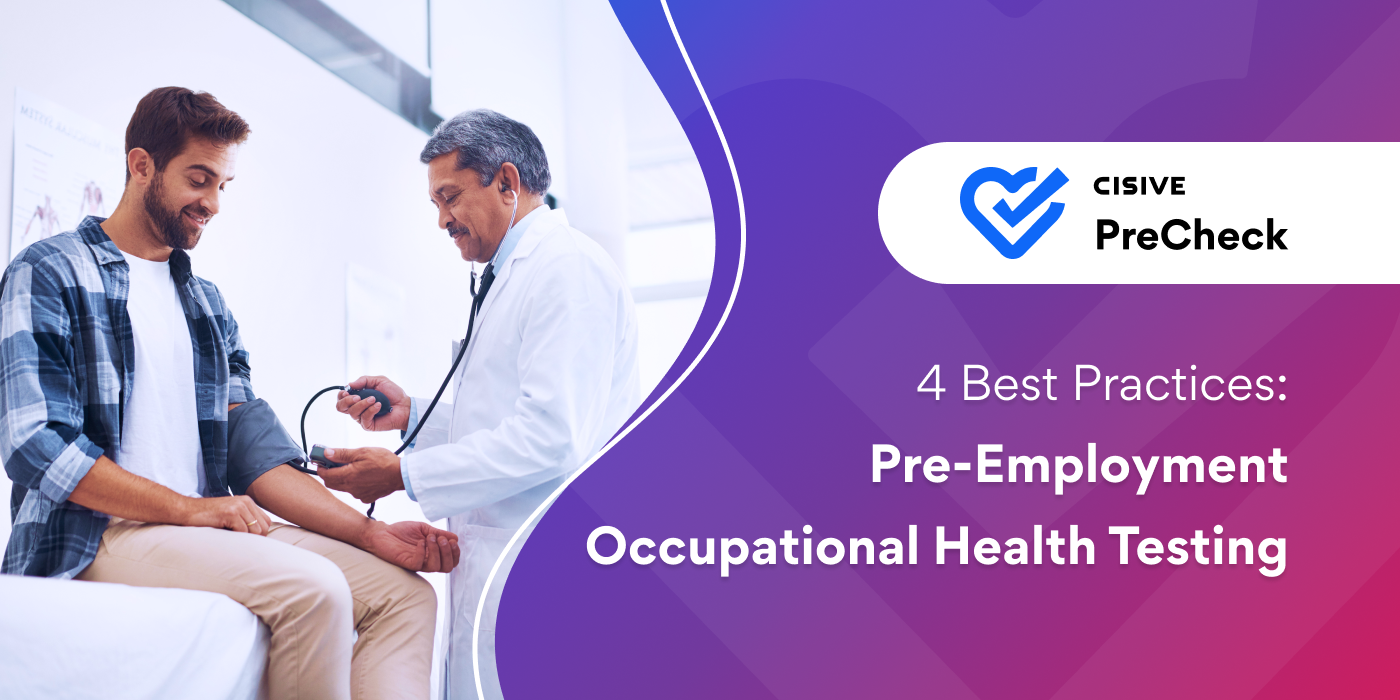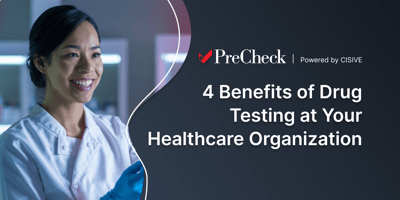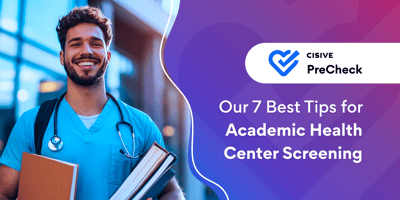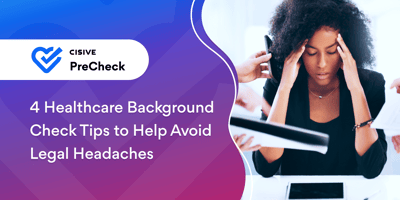

Drug testing in the healthcare industry is standard practice for many organizations, including...

Hiring for healthcare requires more than reviewing a strong résumé or conducting a polished interview. In a setting where quality patient care depends on reliable performance, your team’s physical ability and medical readiness are just as important.
If injuries or mistakes affect your workforce, it's a sign that you need more thorough screening to protect your team and your patients. Pre-employment occupational health services (OHS) help bridge that gap. It’s a practical tool that helps you reduce liability while protecting your patients and making more informed hiring decisions from the start.
Key TakeawaysHere are the key things you need to know about pre-employment occupational health testing:
|
What Is Pre-Employment Occupational Health Testing in Healthcare?
Pre-Employment Occupational Health Testing: 4 Best Practices
Pre-employment occupational health services (OHS) are medical evaluations that help you confirm whether a healthcare candidate is fit for the job before they officially join your team.
Occupational health testing is common for new hires. The exam may include drug testing, immunization checks, physical ability assessments, and screenings that match the specific requirements of the role.
Your medical team relies on OHS to lower injury rates, meet regulatory standards, and improve long-term hiring outcomes. It becomes a practical step toward building a workforce that is compliant and capable of delivering safe, consistent care.
Pre-employment occupational health testing is typically required for roles that involve physical labor or patient care. Look at the responsibilities involved, the environment, and the risks tied to daily tasks. For example, even administrative staff and student healthcare workers will need an occupational health test that checks for communicable diseases if they’ll be around patients.
Here are some of the most critical healthcare positions that require pre-employment exams:
Nurses and personal care assistants, due to their close patient care and work lifting or moving patients.
Emergency Medical Technicians (EMTs), due to their high-stress environments and strenuous physical demands.
Surgeons and surgical technicians, due to their work in sterile environments and the need for stamina during long surgeries.
Physical therapists, due to the lifting and movement demands as well as close contact with patients.
Physicians of all kinds, due to their close patient care.
For these roles and others, occupational health screening can ensure candidates have the physical ability to move patients and equipment safely. Testing and screening for diseases, as well as checking their immunization records, help ensure that you’re not putting patients at risk of further illness.
Some healthcare roles that do not involve direct patient care may still require occupational health testing due to safety concerns. A robust OHS program can protect vulnerable patients and support a safer workplace for everyone on your team.
Pre-employment OHS includes a range of tests that can vary depending on the role. Some focus on mobility testing and strength; others highlight a candidate’s current health; and still others, like verifying required immunizations, are all about patient safety. You may also include lab work or a urine analysis for drug testing.
Each occupational health service evaluates a candidates physical readiness and overall health. Depending on the role, OHS may include:
Physical Evaluation: Review of medical history, blood pressure tests, and other vitals. Getting the full picture of their health history can help you assess their risk factors for the position, and alert you to a candidate’s potential susceptibility to health issues like heart attacks or strokes, especially in high-stress roles.
TB/PPD testing: This lets you confirm that every employee in your building isn’t at risk for developing active tuberculosis.
Immunizations check: Confirming the candidate is up to date on immunizations means they’ll be protected from disease as much as possible.
Titers: Measuring titers, or antibodies, can help determine if the candidate has low immunity to certain diseases. If so, they’d need an immunization or booster.
Vision tests: These ensure the candidate can read and understand information on small vials or charts, especially when color-coded.
Strength tests: There are a variety of tests these could include, all of which ensure candidates would be able to perform physical activities like lifting patients or equipment.
Other common tests and screenings: Vaccinations, respirator tests, and audiograms (hearing tests)
Some occupational health tests must meet specific medical or regulatory requirements. OSHA, state guidelines, and facility rules can all guide which tests should be performed for specific roles.

Before a new hire steps into a clinical or support role, you need a clear process that confirms basic readiness. Pre-employment occupational health testing serves as a checkpoint between the job offer and the first day. A well-structured process helps reduce liability, meet regulatory requirements, and enhance the consistency of your onboarding experience.
OHS provides a safeguard that protects patients, employees, and your facility as a whole. Below are some reasons pre-employment occupational health testing is important in healthcare:
Many healthcare injuries stem from musculoskeletal strain, especially during the first 30 days of employment. New hires may be unaccustomed to patient transfers, long shifts, or fast-paced environments.
A pre-employment occupational health test can reveal poor lifting ability, limited range of motion, or conditions that may have been overlooked. Catching these issues before hire helps lower injury claims and keeps your workers' comp premiums stable.
Healthcare staff can carry asymptomatic infections that spread quickly in patient care areas. Pre-employment screenings can include serologic testing, or titers, to uncover immunity gaps, rather than relying solely on immunization records.
By including titers in your pre-employment occupational health testing, you can identify candidates who may need vaccines or boosters. This bolsters their immunity before they interact with patients, reducing the risk of outbreaks.
Keeping patients safe involves more than just checking a candidate’s name against healthcare sanctions lists. In healthcare, every employee’s clarity, reaction time, and physical ability are essential. A candidate might pass a criminal and employment background check but still be a risk to the organization.
Pre-employment occupational health testing can uncover conditions like unmanaged hypertension, substance use, or medical issues that affect stamina. Each factor plays a direct role in preventing avoidable errors and maintaining a safe care environment.
Let’s say an employee tries to carry equipment that’s too heavy for them. They could drop it, causing it to break. Or they could strain their back, cause a hernia, and be off-duty for weeks to have surgery.
Exams help you identify candidates with limitations that could lead to frequent absences, insufficient abilities requiring more staff to accommodate, or early burnout. By addressing these head-on, you can reduce turnover and lower the need for retraining new hires.
Issues uncovered during a pre-employment occupational health test affect more than just staffing numbers. They touch productivity, patient satisfaction, and budget planning. Over time, a quality OHS program helps you maintain more stable, high-performing teams.
If you don’t screen a candidate, and they cause harm, your entire facility becomes a costly liability.
If a patient comes in with a measles infection and some employees aren’t immunized, your site could become a potential outbreak area. If that happens, will future patients feel safe seeking care from you? Will infected patients sue you for negligent hiring?
A detailed record of pre-employment evaluations can show your due diligence in hiring, even regarding vaccinations. It also protects your organization when auditors or legal teams question your hiring practices, legal compliance, or commitment to patient safety.

Pre-employment occupational health tests help confirm a candidate’s ability to meet the physical demands of the job. But it can only do this when handled correctly.
From knowing when to schedule the exam to choosing the right tests and staying compliant with hiring laws, every detail matters. Working with a reliable administrator reduces delays and helps you maintain an organized and consistent process. Let’s look at some best practices for conducting occupational health tests when hiring job candidates.
Timing is everything. A pre-employment occupational health test must be conducted after you’ve extended a conditional job offer and before you begin onboarding. Doing it earlier can violate federal hiring laws and expose you to legal claims.
Waiting until the offer stage ensures compliance and provides a clearer picture of whether the candidate is physically prepared for the job. It also creates a clear paper trail that supports any adverse action you take. Remember to build the occupational health test into your time-to-hire metric to avoid last-minute bottlenecks or delays.
The tests you include should match the physical demands of the job. An environmental services role may require a lift test or a musculoskeletal assessment. A clinical role might need TB testing, immunization reviews, or respirator fit testing.
Avoid using a one-size-fits-all approach, as it can increase costs and raise legal concerns. Work with your safety officer or medical consultant to select which tests are appropriate for each job category.
Follow ADA and EEOC guidelines when adding OHS to your hiring process. They have strict requirements covering what is legal and what isn’t.
For example, you cannot ask medical questions or require any exam before making a conditional offer. Once that offer is in place, any screening must apply equally to all candidates for the same role. You must also keep medical information separate from regular personnel files and limit access to authorized positions only.
Staying compliant isn’t just about avoiding lawsuits. It protects your hiring integrity and maintains trust with candidates and employees.
Managing OHS yourself can quickly become a logistical nightmare. A third-party administrator can coordinate everything, from scheduling exams to collecting and organizing medical reports. They usually have networks of clinics that understand employer needs and deliver fast, consistent results.
Look for a partner that offers a secure portal for tracking status updates and downloading reports. This kind of setup saves your team time and keeps your hiring process on track. Even more importantly, find one who understands your industry’s risks and requirements and can guarantee compliance.
A service that provides stringent background checks, like Cisive PreCheck, can save you time and money while keeping your workforce safe. You’ll no longer have to worry about hidden injuries, out-of-date immunizations, or potential risks to patients or staff.
PreCheck provides you with full control over pre-employment OHS through a platform designed to keep your process efficient and accurate. Every stage is handled in one place and recorded automatically. Scheduling, documentation, and reporting stay aligned with hiring timelines and your legal requirements.
Our ongoing license monitoring provides up-to-the-minute confirmation that every role is in good hands. The result is a streamlined process that lets you fill critical staffing roles quickly.
Don’t let your hiring process fall apart due to a flawed occupational health test. PreCheck can help you schedule and monitor your pre-employment occupational health test by keeping everything in one place. You move faster, stay organized, and avoid mistakes. Ready to hire with confidence? Let’s put the right system in place.
Contact us today to request a demo or speak with a Cisive expert.
Author: Jessica McDonald
Bio: Product Strategy and Development, Drug Testing and Occupational Health Subject Matter Expert at Cisive
Let's Connect on LinkedIn
Drug testing in the healthcare industry is standard practice for many organizations, including...

Safety and compliance are two ongoing core concerns of any academic health center. Students and...

Healthcare background check compliance is a critical component of the hiring process. Who you hire...